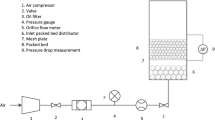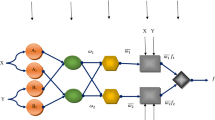Abstract
The challenge of reducing the carbon footprint of many chemical processes and bringing down their development costs can be achieved through process intensification (PI). Different PI technologies have been investigated over the years with rotating packed bed (RPB) technology receiving much of the attention for its potential of significant intensification in terms of hardware size, capital expenditure and operating costs. In this study, we present a complete derivation of the dry pressure drop in RPB that differs from the published models in considering the radial distribution of the gas tangential velocity as well as the viscous shear stress between gas layers. Aorous media approach is adopted to model the viscous and inertial packing resistance forces. The inertial resistance coefficient is derived using machine learning (ML) techniques based on a part of the published data on RPB dry pressure drop (training set). The data learning step relies on the minimization of the absolute error between the pressure drop evaluated from a one-dimensional mathematical model and experimental data to determine the optimum inertial resistance coefficient. Then, an artificial neural network (ANN) is implemented to relate the inertial resistance coefficient to gas flow rate and rotating speed. Finally, the other part of the published data is used to test and validate the proposed approach based on the total pressure drop. The results show that the error in predicting RPB dry pressure drop using the semiempirical model can be reduced from 25 to 2% when a machine learning algorithm is used to estimate the resistance coefficients instead of relying on Ergun's model.











Similar content being viewed by others
Abbreviations
- ANN:
-
Artificial neural network
- \({C}_{2}\) :
-
Inertial resistance coefficient, \(1/\mathrm{m}\)
- \(D\) :
-
Viscous resistance coefficient, \(1/{\mathrm{m}}^{2}\)
- \({D}_{h}\) :
-
Hydraulic diameter, \(\mathrm{m}\)
- \(E\) :
-
Error matrix
- \(I\) :
-
Turbulent intensity, \(\left[-\right]\)
- \(J\) :
-
Jacobian matrix of error
- ML:
-
Machine learning
- \(P\) :
-
Pressure, \(\mathrm{Pa}\)
- \(Q\) :
-
Volume flow rate, \({\mathrm{m}}^{3}/\mathrm{s}\)
- \(\text{Re}\) :
-
Reynolds number, \(\left[-\right]\)
- RMSE:
-
Root mean square error
- \(\overline{U }\) :
-
Total velocity magnitude, \(\mathrm{m}/\mathrm{s}\)
- \({a}_{p}\) :
-
Area density, \({\mathrm{m}}^{2}/{\mathrm{m}}^{3}\)
- \(g\) :
-
Gravitational acceleration, \(\mathrm{m}/{\mathrm{s}}^{2}\)
- \(h\) :
-
Packing height, \(\mathrm{m}\)
- \(k\) :
-
Turbulent kinetic energy, \({\mathrm{m}}^{2}/{\mathrm{s}}^{2}\)
- \(l\) :
-
Characteristic length, \(\mathrm{m}\)
- \(r\) :
-
Radial coordinate, \(\mathrm{m}\)
- \(t\) :
-
Time, \(\mathrm{s}\)
- \(u\) :
-
Absolute velocity, \(\mathrm{m}/\mathrm{s}\)
- \(\ddot{u}\) :
-
Slip velocity, \(\mathrm{m}/\mathrm{s}\)
- \(z\) :
-
Axial coordinate, \(\mathrm{m}\)
- \(\epsilon\) :
-
Turbulent kinetic Energy dissipation, \({\mathrm{m}}^{2}/{\mathrm{s}}^{2}\)
- \(\alpha\) :
-
Permeability, \({\mathrm{m}}^{2}\)
- \(\varepsilon\) :
-
Porosity, \({\mathrm{m}}^{3}/{\mathrm{m}}^{3}\)
- \(\gamma\) :
-
Regularization factor
- \(\lambda\) :
-
Coefficient parameter
- \(\mu\) :
-
Laminar/dynamic viscosity, \(\mathrm{Pa}.\mathrm{s}\)
- \({\mu }_{e}\) :
-
Effective viscosity, \(\mathrm{Pa}.\mathrm{s}\)
- \({\mu }_{t}\) :
-
Eddy viscosity, \(\mathrm{Pa}.\mathrm{s}\)
- \(\vartheta\) :
-
Kinematic viscosity, \({\mathrm{m}}^{2}/\mathrm{s}\)
- \(\theta\) :
-
Output parameter matrix
- \(\theta\) :
-
Angle, \(\mathrm{degree}\)
- \(\rho\) :
-
Density, \(\mathrm{kg}/{\mathrm{m}}^{3}\)
- \(\omega\) :
-
Angular velocity, \(\mathrm{rad}/\mathrm{s}\)
- \(\Omega\) :
-
Rotating speed, rpm
- \(ie\) :
-
Inner edge
- \(oe\) :
-
Outer edge
- \(r\) :
-
Radial direction
- \(z\) :
-
Axial direction
- \(\theta\) :
-
Tangential direction
References
Borhani, T.N., Oko, E., Wang, M.H.: Process modelling and analysis of intensified CO2 capture using monoethanolamine (MEA). J. Clean. Prod. 204, 1124–1142 (2018)
Rao, D.P., Bhowal, A., Goswami, P.S.: Process intensification in rotating packed beds (HIGEE): an appraisal. Ind. Eng. Chem. Res. 43, 1150–1162 (2004)
Neumann, K., Gladyszewski, K., Groß, K., Qammar, H., Wenzel, D., Górak, A., Skiborowski, M.: A guide on the industrial application of rotating packed beds. Chem. Eng. Res. Design 134(443), 462 (2018)
Hilpert, M., Repke, J.U.: Experimental investigation and correlation of liquid-side mass transfer in pilot-scale rotating packed beds. Ind. Eng. Chem. Res. 60(14), 5251–5263 (2021)
Rochelle, G.T.: Amine scrubbing for CO2 capture. Science 325, 1652–4 (2009)
Wang, M., Lawal, A., Stephenson, P., Sidders, J., Ramshaw, C.: Post-combustion CO2 capture with chemical absorption: A state-of-the-art review. Chem. Eng. Res. Des. 89, 1609–1624 (2011)
Wang, M., Joel, A.S., Ramshaw, C., Eimer, D., Musa, NuhuM.: Process intensification for post-combustion CO2 capture with chemical absorption: A critical review. Appl. Energy 158, 275–291 (2015)
Jiao, W., Luo, S., He, Z., Liu, Y.: Applications of high gravity technologies for wastewater treatment: a review. Chem. Eng. J. 313(912), 927 (2017)
Qi, G., Ren, H., Fan, H.: Preparation of CoFe2O4 nanoparticles based on high-gravity technology and application for the removal of lead. Chem. Eng. Res. Des. 147, 520–528 (2019)
Singh, S.P., Wilson, J.H., Counce, R.M., Lucero, A.J., Reed, G.D., Ashworth, R.A., Elliott, M.G.: Removal of volatile organic compounds from ground water using a rotary air stripper. Ind. Eng. Chem. Res. 31, 574–580 (1992)
Kelleher, T., Fair, J.R.: Distillation studies in a high-gravity contactor. Ind. Eng. Chem. Res. 35, 4646–4655 (1996)
Ergun, S.: Fluid flow through packed columns. Chem. Eng. Prog. 48, 89–94 (1952)
Guo, F., Zheng, C., Guo, K., Feng, Y., Gardner, N.C.: Hydrodynamics and mass transfer in cross-flow rotating packed bed. Chem. Eng. Sci. 52, 3853–3859 (1997)
Rao, D.P., Bhowal, A., Goswami, P.S.: Process intensification in rotating packed beds (HIGEE): an appraisal. Ind. Eng. Chem. Res. 43(4), 1150–1162 (2004)
Zheng, C., Guo, K., Feng, Y., Yang, C., Gardner, N.C.: Pressure drop of centripetal gas flow through rotating beds. Ind. Eng. Chem. Res. 39(3), 829–834 (2000)
Neumann, K., Hunold, S., Skiborowski, M., Górak, A.: Dry pressure drop in rotating packed beds-systematic experimental studies. Ind. Eng. Chem. Res. 56, 12395–12405 (2017)
Kumar, M.P., Rao, D.P.: Studies on a high-gravity gas-liquid contactor. Ind. Eng. Chem. Res. 29, 917–920 (1990)
Sandilya, P., Rao, D.P., Sharma, A., Biswas, G.: Gas-phase mass transfer in a centrifugal contactor. Ind. Eng. Chem. Res. 40, 384–392 (2001)
Llerena-Chavez, H., Larachi, F.: Analysis of flow in rotating packed beds via CFD simulations-dry pressure drop and gas flow maldistribution. Chem. Eng. Sci. 64, 2113–2126 (2009)
Lashkarbolooki, M., Vaferi, B., Mowla, D.: Using artificial neural network to predict the pressure drop in a rotating packed bed. Sep. Sci. Technol. 47(16), 2450–2459 (2012)
Rao, D.P., Mehta, R.C.: Torsional-Couette-Flow HiGee. Chem. Eng. Process. 147, 107722 (2020)
Kierzenka, J., Shampine, L.F.: A BVP solver based on residual control and the Maltab PSE. ACM Trans. Math. Softw. 27, 299–316 (2001)
Hendry, J.R., Lee, J.G.M., Attidekou, P.S.: Pressure drop and flooding in rotating packed beds. Chem. Eng. Process. Intensif. 151, 107908 (2020)
Acknowledgements
The authors acknowledge the financial support from Khalifa University of Science and Technology through the grant No. CIRA-2019-031 and the support from Khalifa University of Science and Technology through the grant No. RC2-2018-024.
Author information
Authors and Affiliations
Corresponding author
Additional information
Publisher's Note
Springer Nature remains neutral with regard to jurisdictional claims in published maps and institutional affiliations.
Rights and permissions
Springer Nature or its licensor (e.g. a society or other partner) holds exclusive rights to this article under a publishing agreement with the author(s) or other rightsholder(s); author self-archiving of the accepted manuscript version of this article is solely governed by the terms of such publishing agreement and applicable law.
About this article
Cite this article
Alatyar, A.M., Berrouk, A.S. Machine learning-aided modeling of dry pressure drop in rotating packed bed reactors. Acta Mech 234, 1275–1291 (2023). https://doi.org/10.1007/s00707-022-03428-8
Received:
Accepted:
Published:
Issue Date:
DOI: https://doi.org/10.1007/s00707-022-03428-8




